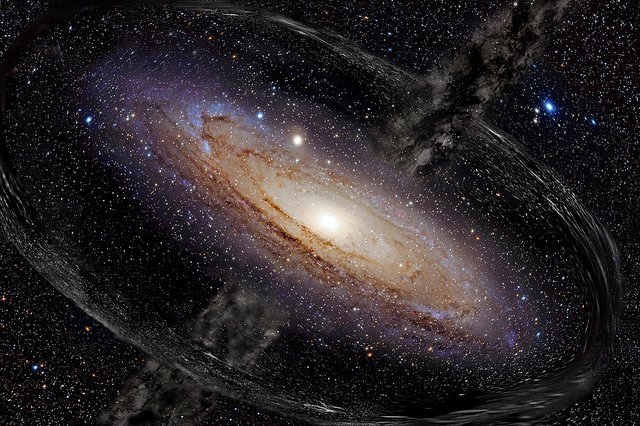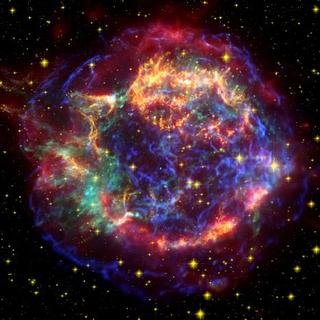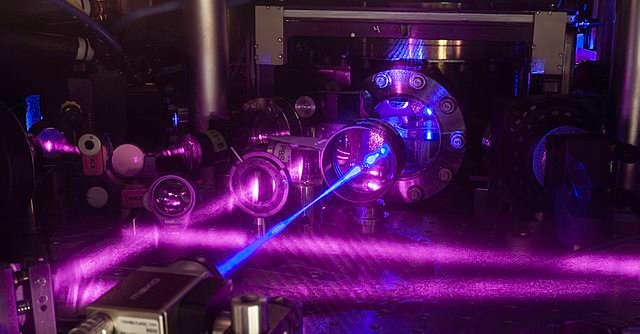Shedding light on dark matter with clocks
The standard model of cosmology successfully provides explanations for most of cosmological observations. It consists in a very simple paradigm in which fixing a very small set of parameters yields an excellent theory-experiment agreement. This being said, alternative cosmologies are not excluded as well, but this is not the topic of the day.

[image credits: Chandra @ NASA (public domain)]
One of the most striking predictions of standard cosmology is definitely the presence of dark matter, some weird substance in the universe whose exact nature is still unknown.
In order to alleviate this issue, many experiments are currently searching for dark matter.
In particular, dark matter is probed through its interactions with normal matter, through cosmic rays and also at particle colliders where it could be directly produced.
However, there is no sign of dark matter so far…
One of the potential reasons could be that dark matter is much lighter than expected. It is in this case not searched for with the appropriate tools, which is why it has not been found yet.
In a recent scientific article, a triplet of researchers have demonstrated that such tools already exist and could be readily used. Light dark matter can indeed be probed… with common devices like atomic clocks.
DARK MATTER IN A NUTSHELL
As said above, dark matter helps a lot for what concerns cosmological data. For instance, it provides an explanation for the circular motion of stars around galactic centers by means of classical mechanics.

[image credits: Maxwell Hamilton (CC BY 2.0)]
Theory and data agreement indeed requires the presence of something dark (i.e. invisible) and gravitationally interacting (i.e. it is matter). This is actually how the dark matter story started, but it is far from ending there.
For instance, dark matter also allows us to explain the properties of the cosmic microwave background, the microwave fossil radiation uniformly filling the universe.
Furthermore, it could also contribute in getting a grip on the formation of large structures in the universe, as well as on gravitational lensing. And the complete list actually is much larger…
However, dark matter still escapes direct detection, despite being at the center of the experimental effort in (astro)particle physics. Numerous instruments hence target dark matter, but did not get any success so far.
One common ground between most these experiments is that they are mainly targeting dark matter particle compliant with the WIMP hypothesis, so that they are far from being general. Before discussing other, non-wimpy, options for dark matter, let us focus a bit on WIMPs.
MORE ABOUT WIMPS
The Standard Model of particle physics is an extremely powerful theory, as after fixing 26 free parameters, its predictions agree with hundreds of thousands of measurements. We can (subjectively) say that it consists in the most tested theory of all time.
However, the Standard Model is plagued by limitations and conceptual inconsistencies so that physicists are convinced that the theory actually realized in nature is an extension of the Standard Model.

[image credits: NASA]
A plethora of Standard Model extensions has therefore been proposed, to tackle those limitations. Many of these theories feature a WIMP as a dark matter candidate (which is why WIMPs are very motivated dark matter particles).
A WIMP is a Weakly Interacting Massive Particle (here is the acronym) and such particles were present in large amounts in the very early universe, being in equilibrium with all other particles. WIMPS were hence annihilating and created at the same rate.
With the expansion and cooling down of the universe, WIMP production stopped (the universe was not warm enough anymore to allow for it) and the WIMP density started to decrease (as WIMP annihilations were still on-going).
A bit further in time, the universe has extended so much that WIMPS were too diluted to meet and efficiently annihilate. Their density hence became constant. The left-over of the initial WIMP density is called the relic abundance of dark matter, and has been measured by Planck collaboration.
This relic of dark matter can be generally predicted correctly in many extensions of the Standard Model if the dark matter particle is weakly interacting and has a mass close to the mass of the particles mediating the weak interactions. In other words, if dark matter is made of WIMPs.
LIGHT DARK MATTER AND ATOMIC CLOCKS
WIMPS have not been observed yet, so that the WIMP hypothesis may not be the one realized in nature. Other options are moreover possible.
Much lighter dark matter is for instance viable, with a dark matter mass being even millions of times smaller than typical WIMP masses. Such dark particles are however not reachable by current of experiments, as they lie outside their window of sensitivity (these experiments have just not been built to detect those super-light guys).

[image credits: Francis Flinch (public domain)]
But we must be pragmatic and try all options, to ensure we are not missing anything. For what concerns light and ultra light dark matter, we hence need to rely on other, potentially novel, experimental detection techniques.
Making use of atomic clocks is one of such options, with the neat advantages those devices exist and are common.
Atomic clocks are the most precise device ever built by humans. They use the energy (or frequency) of the photons emitted during specific atomic transitions (when an atom is getting back from an excited state to its fundamental state) as a standard candle to define time (or the second, precisely).
The presence of dark matter could affect these transitions so that we could measure variations in time of the definition of a second. Those modifications depend on the dark matter mass, so that measuring them provide new handles on dark matter (when dark matter is light). Thanks to the capacities of current atomic clocks, it turns out that dark matter masses that are 10.000.000.000.000.000.000.000 times smaller than a typical WIMP mass can be measured.
SUMMARY AND TAKE HOME MESSAGE
Until now, most searches for dark matter focus on looking for heavy weakly interacting particles, aka WIMPs. However, there is no reason for dark matter to be heavy. Very light options are indeed possible and not excluded by data. In this case, the current experiments are simply not sensitive to dark matter.
Do we have any way to probe dark matter in this case? Yes, but we may need to think about using different devices. In this article, it was shown that atomic clocks, apparatuses that are so precise that they are used to define time (or more precisely, to define the duration of a second) can be used to detect light dark matter. The strategy depicted in the article relies on the fact that dark matter interferes with the frequency of the atomic clocks over time, and those variations can be measured. From there, it is kind of easy to go back to the properties of dark matter.
STEEMSTEM
SteemSTEM aims to build a community of science lovers to make Steem a better place for Science Technology Engineering and Mathematics (STEM). We have recently released our own app, steemstem.io, and we run a witness to support the Steem blockchain.
More information can be found on the @steemstem blog (here for the latest news) and on our discord server.
We are on our way to make Steem a crucial medium for science communication, and it is still time to contribute to this effort!
It's so weird how the true nature of dark matter has remained unknown till now, even with the presence of state-of-the art observatories.
I'm thinking; if dark matter is discovered, would the name still be dark matter, or would it change to white matter? :D
There are so many options for dark matter that is is really likely that we didn't find it yet. For now, a lot of options are excluded, but many still remains un-probed. The paper I discuss actually propose a method to cover more of this "dark matter model space" if we can call it that way.
No, it will stay dark. The dark qualifier comes from the fact that dark matter does not interact electromagnetically (that is a fact, it just can't do it). Since electromagnetism is mediated by photons (or light), here comes the name.
Is it clearer?
Of course it is clearer now. Thanks a lot for taking time to explain
My pleasure my friend!
What is your opinion on the Copenhagen interpretation Vs Hugh Everrit's Many worlds interpretation (also called Theory of the Universal Wave Function) ?
I did mention each in my last article titled : "Cubs Win 2016 World Series"
This is a very active topic in quantum mechanics (and also in philosophy, somehow), and there is no clear answer. Both interpretations have pros and cons. I don't know well enough Everett's work (and its more recent, modified, incarnations) to have a fair judgement on that, so that I prefer to pass. Data-wise (data always wins), both interpretations are fine and until they will be tested against each others, we won't be able to tell. Note that there are ways to distinguish both experimentally, but I don't remember the details (and this is probably not that easy as not done already).
Note that this is slightly off topic relatively to the present post, and this is not really what I am working on (I am not working on the foundation of quantum mechanics).
What is the chance that gravitational force deviates slightly from an inverse square rule at very large distances (as an alternative explanation for dark matter)? I suspect observational evidence may have already ruled this out, but interested to hear your thoughts. btw..Great article as usual :)
The modified gravity option is not ruled out, and it is a quite active field of research. This possibility is very alive (you can check this article that I wrote some time ago). I find it not as supported by data as standard cosmology, but it is on the other hand not excluded yet. And since anything not ruled out is an option... ;)
Thank you that was exactly what I'm after 👍
You are welcome! Feel free to come back to me if you have any other question.
At the points of no return where quantum theory can no longer go with any accuracy, where in the end it is what it is, theory breaks down to where it can be said that there are ghosts waiting to get in and that the broom cupboard is no longer a safe place to hide.
This is causing no little amount of consternation among the scientific community and as you can imagine there is some hair pulling as well, said scientists not being as rough and tumble as they used to be.
Dr Who, who shall remain nameless has gone so far as to say more than can be quantified in such a small book; needless to say, this is being looked into by the experts, whoever they are; and where they come from is beyond deductive reasoning; suffice to say, we are all here one minute and gone the next, just winked out, like a quark in the soup.
So if you do find yourself up near to the points of no return, be it doing the Thursday freebie on Friday, or head in the clouds, or anything else in between do remember to switch off your headlights or your battery will go flat.
I don't see where you want to go. Do you mind clarifying? Thanks in advance.
Note that any single theoretical prediction comes with its uncertainty. Any single experimental measurement comes with its uncertainty. We actually know the level of precision of your calculations.
In the soul stone river where one goes to be immersed in the waters of understanding, the enchantments are re-set and clarity comes; all doors are unlocked and a great freedom descends to wash clean all illusion and scatter the bones of sorrow as dust upon the wind.
All great souls know of this and have said it in their own way to anyone who would listen.
But how do you say what can’t be said?
The heart has secret ways to speak that the intellect can’t comprehend and in this way Knowledge is passed on from one to another in its most profound and simple form.
A baby breathes through its heart all things and in the breathing knows it is as one with all things and so sleeps in the peace of a tranquillity only babies know.
The physics behind dark matter is wide. I have a read a little on dark matter but i still cant figure it out. Maybe with time
A very technical but interesting article on dark matter. Thanks
I wrote simpler articles in the past. You can try, for instance, the links provided here to get a basic introduction (please click on the words dark matter in the post :p).
Thanks. I will go through them
Cool! Please let me know if you have any question.
Once again you have shed some light on dark matter. 😉
Thank you!
Wow... That is a funny one! :D
Very interesting read as usual @lemouth thanks for sharing your knowledge on such a complicated topic.
My pleasure. I love discussing dark matter :)
Hi @lemouth!
Your post was upvoted by utopian.io in cooperation with steemstem - supporting knowledge, innovation and technological advancement on the Steem Blockchain.
Contribute to Open Source with utopian.io
Learn how to contribute on our website and join the new open source economy.
Want to chat? Join the Utopian Community on Discord https://discord.gg/h52nFrV
Very interesting post @lemouth. It is always a pleasure to read your articles. Regards.
Thanks for passing by and your nice words. It is always a pleasure to read them too.